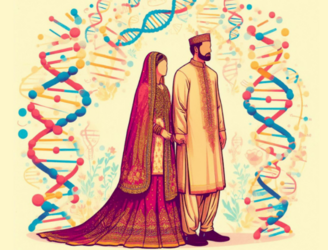
The ‘I do’ that leads to DNA dilemma
Almost half of Pakistani women are married to their first cousins, according to the Pakistan demographic and health survey.
Wara Irfan Published December 4, 2023
“I just want to have a normal child,” said 30-year-old Shazia from Jhelum. She had travelled miles across the country in the quest for a baby that would survive beyond the age of seven.
Married to her second cousin, she has experienced two miscarriages, one induced abortion, and the loss of two children who died at the ages of seven and three.
Sitting inside the air-conditioned room in one of the biggest hospitals in Karachi, Shazia looked visibly anxious. Accompanied by her sister on this long journey to the genetic counselling clinic, she shared her woes.
“All of my children die,” she said. “They appear normal during the pregnancy stage, but six months after their birth, they start exhibiting signs of abnormality and experience intense pain before passing away.”
After the birth of her first two children, who endured a life of agony, she made the difficult decision to terminate her third pregnancy, fearing another child might suffer the same fate. Following this, her next two pregnancies ended in miscarriages.
Shazia’s husband is her mother’s first cousin. Similar to many consanguineous families, hers has a prevalence of cancers among its members.
Consanguinity involves the mating between “two individuals characterised by the sharing of a common ancestor(s)”, increasing the likelihood that a child will inherit two copies of the same disease.
Simply put, we each have two copies of every gene, inherited from both our parents. If both the mother and father possess a flawed copy of a gene, the likelihood of the child inheriting both defective copies increases. Since family members share similar genes, the chances of the child receiving these faulty gene copies also rise.
Shazia visited Aga Khan University Hospital (AKUH) to inquire about the possibility of having a healthy baby in her next pregnancy. Her optimism is not unfounded because, even when both parents carry the same recessive disorder, meaning they have a faulty copy of a gene without it manifesting as an illness, the probability of their child inheriting both faulty copies is 25 per cent — there remains a 3/4th chance that their child will be healthy, albeit potentially a carrier.
Autosomal recessive disorders
Autosomal recessive disorders are a specific type of condition where both parents are carriers. “Everyone is a carrier of something or the other,” explained Dr Salman Kirmani, Chair and Associate Professor in the Division of Women and Child Health and a geneticist at AKUH.
“On average, it is believed that a human being is a carrier of two or three different diseases, but they may not be aware of it. Marrying within the family increases the likelihood of carriers coming together compared to marrying outside,” he added.
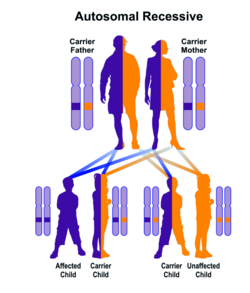
This doesn’t imply that if you have four children, one will have the disease, one will be entirely healthy, and two will be carriers. Instead, it signifies that each time fertilisation occurs — during conception — there is a 25pc chance of an unaffected child, a 25pc chance of an affected child, and a 50pc chance of a child being a carrier. Each of these probabilities is independently applicable every time fertilisation takes place.
This phenomenon explains why certain genetic diseases, such as thalassemia, cystic fibrosis, and spinal muscular atrophy (SMA), are more prevalent in Pakistan compared to Western countries, given our high consanguinity rate.
As Shazia’s children have all passed away, it is challenging to determine whether the condition they suffered from was indeed genetic. She is not the only one facing this predicament.
According to the Pakistan Demographic and Health Survey 2017-18, almost half of the women between the ages of 15 and 49 in Pakistan reported marrying their first cousins.
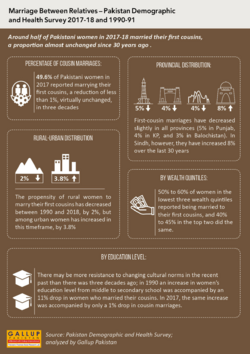
These numbers don’t account for people within the same community. For example, Dr Kirmani mentioned, “If you ask a couple who come from a particular community, they may say, we don’t marry our cousins. But because they are a small, close-knit community, they share common ancestors.”
Another common practice is people marrying within the same caste, thereby perpetuating generations of consanguinity. “In Pakistan, there are geographically isolated villages where members frequently marry their first cousins for generations.”
Akin to Shazia, Akbar and Fatima walked into the genetic counselling clinic with their two children, aged three and one. Both boys exhibited stunted growth and delayed motor responses compared to average children their ages.
The parents’ mothers were siblings, making them first cousins. They were also related on their paternal side, further increasing the consanguinity level between the two.
Concerned about the health of their next child, they came to the clinic hoping to discover ways to reduce the risks of abnormalities in future pregnancies.
This wasn’t the first time they sought medical advice. They had previously consulted a doctor in Lahore who simply attributed their situation to “cousin marriage,” placing the blame squarely on their decisions.
However, dismissing the sociocultural context that contributes to cousin marriages and laying blame solely on individuals is unfair.
The blame game
Dr Kirmani strongly believes that consanguineous unions are often subjected to oversimplified criticism instead of nuanced analysis.
“In educated circles in Pakistan, especially among doctors, there is often a strong stance against cousin marriages. Couples are made to feel guilty, as if ‘you married your cousin, so this happened,’” he said.
“How heartless is that?” he exclaimed. “If I were to conduct a lecture with a hundred doctors in attendance, and I asked how many of them are married to their cousins or have parents who are cousins, half the room would likely raise their hands. Some might be so embarrassed that they wouldn’t even raise their hand.”
Consanguinity is so “culturally ingrained” in our society, he pointed out, that it does not make sense to attack individual choices.
People assume that Dr Kirmani would be more against cousin unions as he is a geneticist. However, he believes that marriage between a man and a woman is their business. “I, as a doctor or any government or religious person, should not influence what they decide to do. The basic principle here is autonomy.”
Certainly, there are risks, and doctors should educate people about them. However, it’s crucial to understand that even in a non-consanguineous union, there is a “one or two per cent chance of birth defects.” There is also always a chance that someone outside one’s family could be a carrier of a faulty gene.
Many advocate for laws prohibiting cousin marriages. In fact, in Sindh and Khyber Pakhtunkhwa, provincial assemblies passed a law a decade ago making thalassemia testing compulsory for married couples.
However, like other laws, this one not only lacks enforcement but also doesn’t consider potential adverse consequences, particularly for marginalised groups. “Let’s suppose a man and a woman [in a village or a close community] get the test done, and they both turn out to be positive,” says Dr Kirmani. “There are preparations for the wedding at home, everything is happening — now what? Will you say, ‘Go your separate ways’?”
Moreover, there are no strict measures in place to keep such information confidential. “In our society, everything is often blamed on the woman, and nothing is kept private.” If the couple decides to not proceed with their union, the man is more likely to find a partner outside the family “without ever disclosing that he is a carrier”, while the woman would be “condemned in the whole community in the village that ‘iska khoon kharab hai, isse shaadi nahi karna [her blood is bad, don’t marry her]’.”
Given the potentially dire consequences of population testing, laws regarding genetic testing must be carefully considered, taking local contexts into account. Furthermore, such laws also tend to increase distrust of the medical community among groups in a society that already harbours mistrust for doctors, argued Dr Kirmani.
On one hand, “we can’t have a purely medical viewpoint and say that ‘it is stupidity, why should we let our nation do stupid things, we should enforce [laws] because people don’t have a mind of their own.’ On the other hand, we shouldn’t have a purely cultural standpoint that ‘since it is part of our culture, we should not talk about it’,” he said.
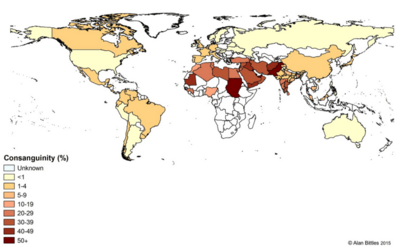
Educating people about the risks also comes with its own challenges. “How do you explain a disease to the couple they have never seen or witnessed? How will you truly educate them and present them with an accurate picture so they can make an informed decision?” he asked.
He finds it easy to counsel people when the disease runs in the family because those individuals have witnessed the negative impacts of the illness closely.
However, it becomes challenging when doctors must be aware of the socioeconomic disparities between their patients. “I can’t have double standards, telling someone from an educated family in Defence to ‘get this $500 test done, you will know all the diseases, then it’s your choice.’ But if I go into a [rural] community, I say ‘Khabardar! Cousin marriage nahi karna [Don’t you dare marry your cousin].’ I have to maintain the same standard.”
The good, the bad and the ugly
To further complicate the issue, Dr Kirmani pointed to some perceived ‘benefits’ of consanguineous unions. “Imagine you are a parent living in a remote area. You know all the boys because they are from your family. If you want to marry outside the family, then you will have to marry [someone that lives] like 200 km away from your own village.”
“Once that marriage is done, your daughter is gone, and you won’t be able to see her at all.” The “desire to keep the child close” prompts people to marry their children to relatives. Secondly, different villages have different customs, and some parents worry about the potential treatment of their daughter in a distant household that differs from their own.
Furthermore, studies have found that “being married to a first cousin on either the father’s or mother’s side was associated with a decreased likelihood of abuse when compared with another relationship” in Pakistan.
This perception encourages parents to marry their daughters to close relatives in the hope that if a conflict arises, they would be able to easily intervene.
In 2019, The BMJ medical journal reported the case of Javed Tahir in Islamabad, who has suffered from muscular dystrophy since childhood. The genetic condition, which ran in his family, would “lead to total paralysis” gradually. Tahir, committed to breaking the tradition, wanted to be the first in his family to marry outside.
He looked for a partner outside their family for a decade but was unsuccessful due to his condition — leading to him eventually marrying his own cousin.
Situations like Tahir’s illustrate that often it is difficult, even impossible, for individuals to break the cycle.
Similarly, women in rural areas with limited interactions with men outside their families reduce their chances of meeting potential suitors who are not related to them.
The risks surrounding cousin marriages can be understood against this backdrop. For instance, consider a family with a history of thalassemia. They had a baby who died at the age of 10 due to complications of thalassemia, as most children in this country do not survive between 10 and 20 years of age.
“Now they want to have another child. You test them and find out that they are carriers. Then you inform them that their child would have a 25pc chance of having the disease,” said Dr Kirmani.
As a doctor, he can offer them a prenatal diagnosis. Prenatal diagnosis occurs when the woman becomes “pregnant naturally and carries the pregnancy through with routine procedures until about 12 or 13 weeks of gestation.” At 12 weeks, doctors can perform a test called Chorionic villus sampling (CVS), and at 14 weeks, they can conduct another test called amniocentesis.
“Amniocentesis involves sampling the amniotic fluid around the baby, while CVS entails taking a small biopsy of the placenta, where the blood mixes between the mother and the baby. But it has baby tissue, so the baby’s DNA can be extracted out of it. The purpose of both is to retrieve the baby’s DNA.”
The extracted DNA is then examined for common genetic diseases, such as thalassemia in this case. If there is a 75pc chance that the gene for it is not inherited, the parents can be reassured, and they can choose to continue the pregnancy. However, if the 25pc chance results in a positive diagnosis for the illness, what options do the parents have?
“There is no treatment [for thalassemia]. So, their options are that they can terminate the pregnancy … It’s a personal choice,” the geneticist said.
“You can’t go on a warpath, telling parents they should suffer the consequences because they were ‘stupid’ enough to take this chance. Offer them options. Don’t dictate to them, saying, ‘You must terminate’ or ‘Oh no, it’s really wrong to terminate’. Put the options in front of them. Help them decide. This is called ‘shared decision-making’ in medical terms. Share their burden so that they don’t feel guilty.”
He went on to say that there is a great sense of guilt and responsibility, especially for mothers who often blame themselves, thinking it’s their fault or that something went wrong during the pregnancy. For both medical and ethical reasons, it is a sound decision for diseases associated with suffering, misery, pain, and a shortened life or an extremely low quality of life. Thalassemia indeed fits into that category.
In other countries, including neighbouring Iran, the survival rate has gone up to 40 or even 50 years of age, thanks to the availability of resources. “Our survival is not beyond 20, and it’s 20 miserable years of blood transfusion every two weeks,” lamented Dr Kirmani.
“If you go to any thalassemia centre, you will see something akin to an international airport. There would be a big lounge where 25 to 50 children would be sitting and watching television while receiving blood transfusions. Often, these kids become iron-overloaded, leading to major complications affecting their hearts and all their internal organs. It is a horrible existence. They cannot attend school regularly because they are constantly stuck in this cycle. It is a never-ending cycle once it begins.”
Thalassemia centres have more of a “petrol pump” approach, transfusing blood for any and every reason. The medicines to reduce iron levels are also very expensive and have various side effects.
Blood transfusion at Sundas Foundation Centre on the World Thalassaemia Day — APP/File
“It takes a lot of resources, a lot of time, and completely shatters their quality of life — yet [the children] still die. They die [after living] a very poor existence,” he added.
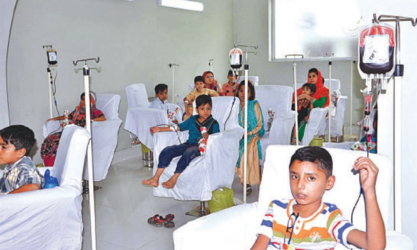
Even though there is now a cure for it abroad — a bone marrow transplant — it is extremely expensive and inaccessible for most in Pakistan. There are 10 million β-thalassemia carriers in the country and around 5,000 children are diagnosed with thalassemia every year.
“How many of them can receive this treatment?” the doctor asked, rhetorically.
Costs and treatments aside, it is an extremely painful experience for the parents, leading them into an “endless cycle of poverty” where, for 20 or so years, they are “financially and emotionally devastated. They have to compromise for the other children in the house because the mother cannot pay attention to them, and the father has to earn for the endless transfusions.”
He pointed towards the immense lack of awareness since these parents do engage with doctors, but no one effectively counsels them to prevent having more children with the disease. “We have seen two or three kids [with the disease] in the same family.”
“If they [people] are not listening to you, why are they not trusting you?” he asked the medical professionals. “Talk to the moulvis, talk to the community leaders, do the outreach. If we sit in our crystal palaces and imagine that we are the educated and they don’t know what they are doing, this cycle will continue.”
The $2 million cure
Similar to Thalassemia, Spinal Muscular Atrophy (SMA) poses a unique set of challenges to the Pakistani population due to its frequent occurrence as well as “limited resources and access to healthcare” in the country.
Even though it is a common disease in Pakistan, it seldom gets the attention it deserves. “It does not get the visibility of thalassemia because instead of 20 years, you die within two years of age.”
In SMA, the child is born healthy, but by six months of age, “parents realize that something is wrong.”
“The [baby] is not moving its head, it’s not moving its limbs, and it slowly loses power in its muscles, it stops breathing, or it has very shallow breathing, it can’t swallow, so it starts swallowing the milk that goes down its lungs, they get pneumonia, and it dies,” said Dr Kirmani.
The doctor has seen multiple families where two or three children suffer from SMA.
He proceeded to show me the first gene therapy vial for the disease in the world, framed in his office.
Novartis, an multinational company launched a “managed access programme” where essentially they would provide a hundred doses of the treatment around the world, given how expensive it is. The Zolgensma (onasemnogene abeparvovec) treatment costs a whopping $2.1 million.

The Zolgensma treatment adminstered by Dr Salman Kirmani — Author
“They didn’t call it a lottery because they couldn’t. But that is what it was. Every doctor worldwide who has a patient enters their patient’s details and everything. After every two weeks, the lottery comes out. And the one whose name is selected gets the dose.
Dr Kirmani entered 50 names in the ‘lottery,’ but only five of them got the dose. The other 45 children passed away.
“Parents used to call and ask, ‘Doctor sahab, did we get our name in the lucky draw or not?’”
Waiting is a fatal process for most. He called two families to congratulate them that their child’s name was selected and to bring the child. The parents told him that the baby died a week prior.
“Can you imagine getting that phone call?” he asked.
Considering the dire consequences and the harsh reality of these illnesses, the debate surrounding consanguinity becomes even more intricate. On one hand, the principle of individual autonomy is paramount; on the other, the lack of resources for the majority of the country’s population cannot be disregarded.
Nevertheless, in light of the ineffectiveness of laws and policies in Pakistan, the issue cannot be simplified or resolved with a broad stroke of universal bans. A collective effort is needed, involving medical professionals, religious scholars, and local communities, to engage with each other and come up with pragmatic and realistic solutions that consider the practical challenges faced by the majority of people in the country.
Perhaps, only then we can prevent many others like Shazia from pleading to have a healthy child.
The author is a KAS-Dawn.com media fellow, interested in the intersection of gender, visual cultures and lived experiences.

(+)
Source : https://www.dawn.com/news/1788103